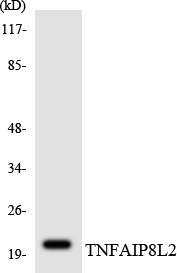TNF-IP 8L2 Polyclonal Antibody
- Catalog No.:YT4686
- Applications:WB;ELISA
- Reactivity:Human;Mouse;Rat
- Target:
- TNF-IP 8L2
- Gene Name:
- TNFAIP8L2
- Protein Name:
- Tumor necrosis factor alpha-induced protein 8-like protein 2
- Human Gene Id:
- 79626
- Human Swiss Prot No:
- Q6P589
- Mouse Gene Id:
- 69769
- Mouse Swiss Prot No:
- Q9D8Y7
- Rat Gene Id:
- 310663
- Rat Swiss Prot No:
- Q6AYJ8
- Immunogen:
- The antiserum was produced against synthesized peptide derived from human TNFAIP8L2. AA range:11-60
- Specificity:
- TNF-IP 8L2 Polyclonal Antibody detects endogenous levels of TNF-IP 8L2 protein.
- Formulation:
- Liquid in PBS containing 50% glycerol, 0.5% BSA and 0.02% sodium azide.
- Source:
- Polyclonal, Rabbit,IgG
- Dilution:
- WB 1:500 - 1:2000. ELISA: 1:40000. Not yet tested in other applications.
- Purification:
- The antibody was affinity-purified from rabbit antiserum by affinity-chromatography using epitope-specific immunogen.
- Concentration:
- 1 mg/ml
- Storage Stability:
- -15°C to -25°C/1 year(Do not lower than -25°C)
- Other Name:
- TNFAIP8L2;Tumor necrosis factor alpha-induced protein 8-like protein 2;TIPE2;TNF alpha-induced protein 8-like protein 2;TNFAIP8-like protein 2;Inflammation factor protein 20
- Observed Band(KD):
- 20kD
- Background:
- domain:The central region was initially thought to constitute a DED (death effector) domain. However, 3D-structure data reveal a previously uncharacterized fold that is different from the predicted fold of a DED (death effector) domain. It consists of a large, hydrophobic central cavity that is poised for cofactor binding.,function:Acts as a negative regulator of innate and adaptive immunity by maintaining immune homeostasis. Negative regulator of Toll-like receptor and T-cell receptor function. Prevents hyperresponsiveness of the immune system and maintains immune homeostasis. Inhibits jun/ap1 and NF-kappa-B activation. Promotes Fas-induced apoptosis.,similarity:Belongs to the TNFAIP8 family. TNFAIP8L2 subfamily.,subunit:May interact with CASP8; however, such result is unclear since PubMed:19079267 could not reproduce the interaction with CASP8.,
- Function:
- domain:The central region was initially thought to constitute a DED (death effector) domain. However, 3D-structure data reveal a previously uncharacterized fold that is different from the predicted fold of a DED (death effector) domain. It consists of a large, hydrophobic central cavity that is poised for cofactor binding.,function:Acts as a negative regulator of innate and adaptive immunity by maintaining immune homeostasis. Negative regulator of Toll-like receptor and T-cell receptor function. Prevents hyperresponsiveness of the immune system and maintains immune homeostasis. Inhibits jun/ap1 and NF-kappa-B activation. Promotes Fas-induced apoptosis.,similarity:Belongs to the TNFAIP8 family. TNFAIP8L2 subfamily.,subunit:May interact with CASP8; however, such result is unclear since PubMed:19079267 could not reproduce the interaction with CASP8.,
- Subcellular Location:
- cytoplasm,
- Expression:
- Lymph node,Pancreas,Small intestine,
- June 19-2018
- WESTERN IMMUNOBLOTTING PROTOCOL
- June 19-2018
- IMMUNOHISTOCHEMISTRY-PARAFFIN PROTOCOL
- June 19-2018
- IMMUNOFLUORESCENCE PROTOCOL
- September 08-2020
- FLOW-CYTOMEYRT-PROTOCOL
- May 20-2022
- Cell-Based ELISA│解您多样本WB检测之困扰
- July 13-2018
- CELL-BASED-ELISA-PROTOCOL-FOR-ACETYL-PROTEIN
- July 13-2018
- CELL-BASED-ELISA-PROTOCOL-FOR-PHOSPHO-PROTEIN
- July 13-2018
- Antibody-FAQs
- Products Images

- Western blot analysis of the lysates from HeLa cells using TNFAIP8L2 antibody.



